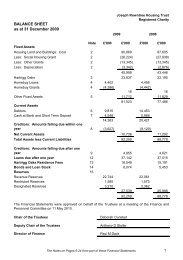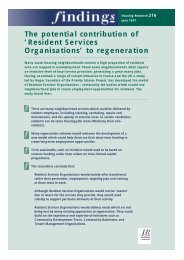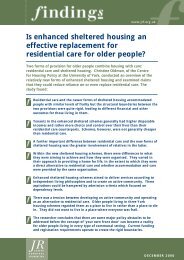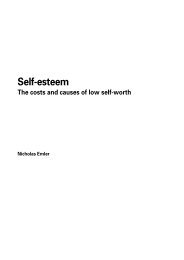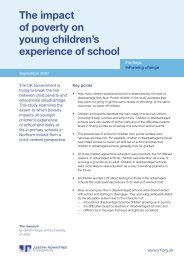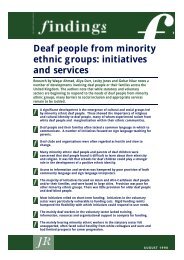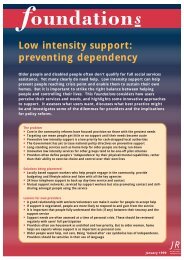Community participation - Joseph Rowntree Foundation
Community participation - Joseph Rowntree Foundation
Community participation - Joseph Rowntree Foundation
Create successful ePaper yourself
Turn your PDF publications into a flip-book with our unique Google optimized e-Paper software.
Executive summary<br />
The bottom line<br />
The three most important assumptions underpinning policy are that:<br />
1 if you create structures for community <strong>participation</strong>, you create social capital from<br />
which the community will benefit<br />
2 the community will benefit because enough people will want to participate in<br />
these structures<br />
3 they will want to participate because these structures will be embedded in the<br />
everyday spaces of community life and the informal social networks through<br />
which people live their lives.<br />
Our findings suggest that these assumptions do not stack up. <strong>Community</strong><br />
<strong>participation</strong> tends to be dominated by a small group of insiders who are<br />
disproportionately involved in a large number of governance activities.<br />
What social capital is created by opening up governance to community involvement<br />
tends to be concentrated in the hands of this small group. The already well<br />
connected get better connected. There is no guarantee that the wider community<br />
feels the benefit of this social capital, because formal governance structures are<br />
often not embedded in the informal everyday spaces of community life – mothers<br />
and toddlers’ groups, book clubs, faith groups – in a way that would make them easy<br />
for the average citizen to access or navigate. These institutions, so good at<br />
mobilising people to get involved in civic activities, are often not set up or supported<br />
to convey that involvement into more formal arenas.<br />
If we want to ensure that there are stronger links between community <strong>participation</strong> in<br />
governance and social capital, then pushing harder on the existing approach is likely<br />
to be counter-productive. Simply encouraging more people to participate seems a<br />
somewhat forlorn hope given the range of forces helping to perpetuate the current<br />
division between insiders and outsiders, while creating even more structures is likely<br />
just to increase the burden on a few already over-stretched community activists.<br />
The alternative is to try to find the points where stronger and more effective<br />
connections can be made between formal <strong>participation</strong> by a small group of insiders<br />
and the more informal, everyday social networks in which a much bigger group of<br />
citizens spend a significant part of their lives. Rather than expect everyone to<br />
participate equally in formal governance, we should try to make more people’s<br />
everyday civic engagement count by designing the formal structures of governance<br />
xi




